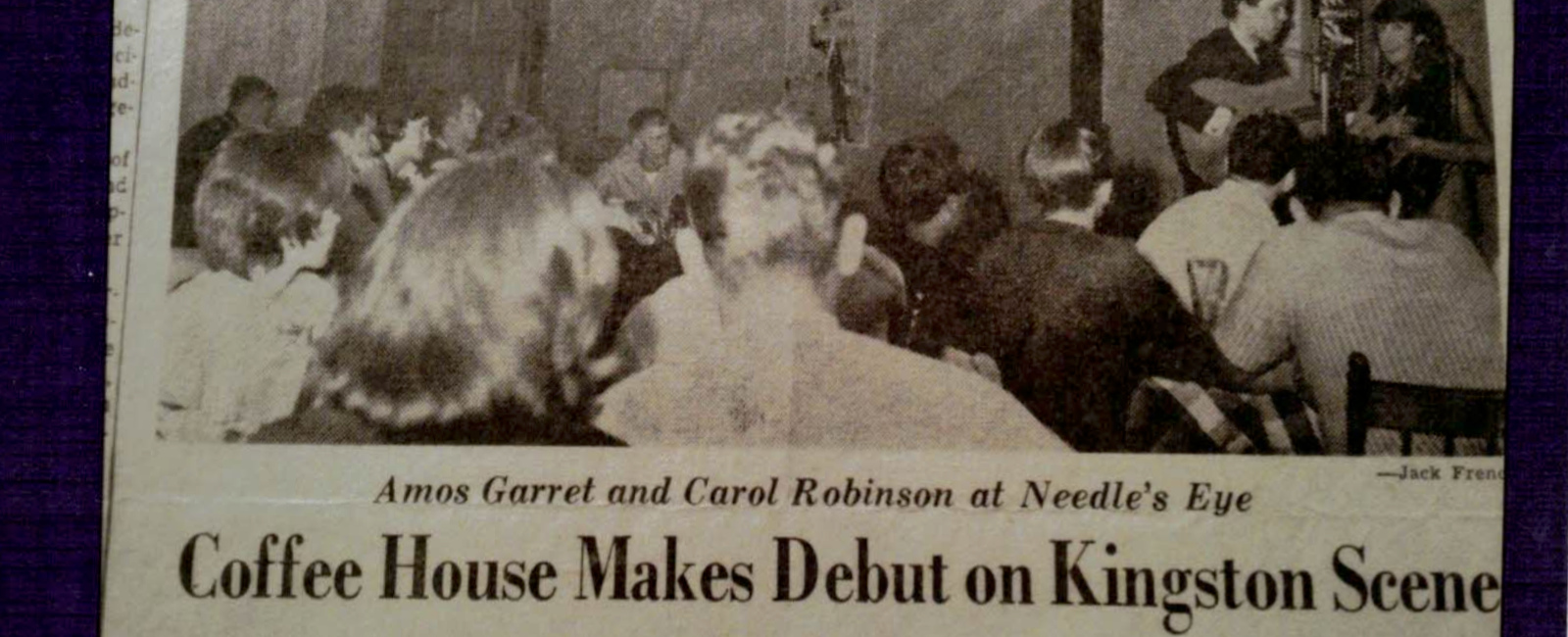November 10, 2025
Support the Belfry’s 50th Anniversary Season
As we celebrate the Belfry’s 50th season, it’s worth remembering that this theatre— this gleaming gem on the Canadian arts…
Read more
By David Stocks
In the summer of 1964, two friends and I created a folk song club in Kingston, Ontario. We had full-time jobs in the Army, but we wanted folk music in our daily lives. We were immersed in the folk music of Joan Baez, The Kingston Trio, Peter Paul & Mary, Pete Seeger, John Runge, the Weavers, and similar performers.
We rented a former plumbers’ warehouse on the third floor of an old building at 111 Brock Street. It was a filthy, rectangular room of about 2,000 square feet. We built a kitchen, two washrooms, and an entrance counter at one end. We bought about 20 small tables and about 90 chairs at the local used furniture place. Along one long wall, there was a space where a table could have been placed. That was our performance space. It was illuminated by a couple of spotlights. Very primitive!
We opened The Needle’s Eye in September with the duet of Amos Garrett and Carol Robinson. Amos was a superb guitar player who performed with Maria Muldaur, and Ian & Sylvia, among others. Carol Robinson was a singer who was also the hilarious, rubber-faced comedienne who appeared on numerous Wayne & Schuster shows.
Both Amos and Carol were members of the “jug” band called The Dirty Shames. The band performed in The Needle’s Eye later in 1964.
To help us with planning this venture, we visited two successful clubs: The Purple Onion in Toronto; and L’Hibou in Ottawa. We established loose affiliations with those places so we could share opinions about various acts. We could also book acts for more than the usual single week, which led to greatly reduced costs. For example, we were able to book the Canadian recording artist trio The Couriers for five weeks: two weeks in The Purple Onion, a week in The Needle’s Eye, then two weeks in L’Hibou. There was no way we could afford The Couriers for a single week.
We established some policies to treat the performers well. One policy was that the manager introduced every set. In other clubs, the manager only introduced the first set. For subsequent sets, the performers had to go to the performance space, tune their instruments, and hope that the audience would quiet down and start to pay attention. Our policy was popular with the performers.
One evening in October, as I sat in the Club, the manager came to me and said, “Gordon Lightfoot is on the phone.” I had never heard of Gordon, so the conversation went:
“So?”
“He wants a gig.”
“What do you think?”
“I think we should give him one.”
“Go ahead.”
Gordon’s first gig at The Needle’s Eye was in November. For $150, he drove to Kingston in his black Chevrolet Corvair and played for four nights: Wednesday-Saturday. He stayed at a cheap hotel for about $10/night.
Gordon worked hard at his craft. He rehearsed every afternoon for several hours. He came to the Club well before the 8 p.m. starting time and played past the 11 pm ending time. This was a welcome change from other singers who did not rehearse, started late, and ended early.
After the shows, we owners, the staff, and the performers would often have a meal of Chinese food from a nearby restaurant. That place gave us 30% off because we would take a large quantity of their leftover food. After the meal, some of us would go back to my apartment and continue to jam, despite the occasional unpleasant incidents with neighbours. I had the pleasure of sitting beside Gordon on the sofa in my living room as we both played our guitars and sang some of his songs. What an honour!
According to the standards of the industry at the time, the “house” had the right to get the talent back one more time under the same terms. Because we were so impressed by Gordon, we booked him for January.
Much to our surprise, Gordon became famous at the end of 1964 because Peter, Paul, and Mary released two of his songs: Early Morning Rain and That’s What You Get For Loving Me. Gordon went to NYC for the release of the records. He met several famous performers and got to perform for them. He was astounded by his success!
When he came to us in January, he was almost delirious and was shaking badly as he told us about the trip. I had to tune his 12-string guitar so he could perform.
Three months later, the same man, playing the same songs, was earning $3,000/night! I cherish the thought that his time at The Needle’s Eye might have helped a bit to build his career. He certainly gave me a lifetime of wonderful memories.
P. S. The Needle’s Eye became well known in the Kingston area. When senior Army officers found out what we were doing, they posted me to Calgary, Pat to Gagetown NB, and Ken to Gaza, where Canada had a military outpost. The Needle’s Eye folded by May 1965.
David Stocks attended Royal Roads Military College in Victoria and the Royal Military College of Canada in Kingston. After three years in the Army, David joined IBM and pursued a career as a management consultant. He remains a keen singer in various choral groups with occasional solo gigs.
November 10, 2025
As we celebrate the Belfry’s 50th season, it’s worth remembering that this theatre— this gleaming gem on the Canadian arts…
Read moreOctober 16, 2025
THE BELFRY THEATRE (Victoria, BC) is seeking an individual of creativity, vision, andexperience to serve as its next Artistic Director.…
Read moreOctober 14, 2025
How our journey to Burning Man helped fuel Fernwood’s artistic transformation by John Threlfall Look around Fernwood today and you’ll…
Read more